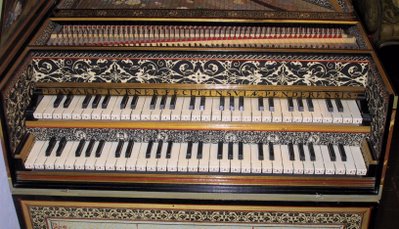
A quick search on the net about plants and music will quickly turn up a myriad of articles all pretty much espousing the same thing: plants shrivel and die if exposed to non-stop Rap or Heavy Metal, but blossom and bloom when exposed to Bach, Scarlatti, Vivaldi, and classical Indian Sitar music. To most people, this probably sounds reasonable. One weeps for today's youth when they drive by in their lowered and amplified cars, pumping out thousands of watts of sound and making the car alternately implode and explode in time to a pulsing thud. "Our amps go to 11." Thus, the idea that nature, and plants in particular, side with what is largely perceived as civilized tastes resounds with reason and echoes our own particular wishes. "Our amps go to 0". It's a shame that it's just not the case. There is no research to prove that plants prefer baroque music. Were that it were so....
There is a huge amount of pseudoscience around this topic, but hard scientific information is, to say the least sketchy. Given the same sound levels, frequency outputs, and all other conditions being identical, plants do not seem to care what music is played. There is a catch, however. Plants do seem to grow better with music than without, the current thinking being that sound tends to excite plant tissue on a molecular level which causes the plant to regenerate and grow bigger roots and leaves which aids in nutrient and photosynthetic absorption, etc. But apparently only to a point. Loud sonic vibration can permanently damage cell membranes. This is probably the origin of much of the bad science regarding rock n' roll and plants withering.The fact of the matter is that plants have been growing for millions of years, and have been doing so surrounded by all the things they need to thrive - birds, bugs, wind, water , all of which produce sound. Growing in absolute silence is a completely unnatural environment for most plants. Sonic vibrations which most closely mimics natural sounds are likely to produce better growing results. That already narrows the taste in music to accoustic. Do sitars and baroque harpsichords sound more like birds and bugs than, say, Snoop Doggy Dogg? Probably. ( I only mention the famous Gangsta rapper as an example because, in a bizarre twist, Winter Harp played side by side with Mr. Dogg in a twin theatre complex in Calgary a few years ago. I can imagine patrons arriving at the multiplex going, "well, Winter Harp is sold out, let's go see Snoop").
Aside from corn, plants don't have ears (it's a joke, see?) so their perception of sound is already going to be very different. However, they do sense vibration very accurately. One plant that responds particularly well to sound-induced vibration is Mimosa pudica, also known as the "sensitive plant." Vibrations induce electrical signals across the leaflets of this plant, and cells at the base of the leaflets respond to these action potentials osmotically. This response results in a sharp change in the turgor pressure in the pulvinus cells, and that pressure change, in turn, results in the folding of the blade at the pulvinus. Another pulvinus at the base of the petiole may also respond if the vibration is severe enough. How would this plant respond in terms of growth if its leaves were kept closed by constant vibration? If you think very long about photosynthesis in leaves as the driving force for growth, you will realize that continuous leaflet closure would inhibit rather than stimulate the growth of the plant.
One of the first people to systematically study plant growth and the stimuli involved was also the very first person to send and receive radio waves. You're probably thinking "Marconi studied plants?" Actually, no he didn't. But he was not the inventor of the radio either, despite the fact that he usually gets credit for it. Jagadis Chandra Bose sent and received radio waves in 1895, more than two full years before Marconi. Would the fact that he was a Bengali explain his relative lack of recognition for this feat? Marconi had the best equipment and worked within the scientific community in Europe. Bose did it virtually in isolation, using equipment he invented using tools that he built himself, in Calcutta. Marconi patented everything, and became quite wealthy, marrying into nobility and eventually becoming one of the leaders of the Italian Fascist party. Bose did not believe in patents, and thought that all knowledge should be for the benefit of all humanity. It is pretty obvious which is the more significant achievement. Bose went on to write several incredible books (now out of print and very difficult to get) regarding hundreds of experiments he conducted determining the nature of plant consciousness.Bose demonstrated that plant tissues under different kinds of stimuli like mechanical, application of heat, electric shock, chemicals and drugs, produce electric response very similar to that produced by animal tissues.
For his investigations Bose invented several novel and highly sensitive instruments. Among these the most important one was the Crescograph -an instrument for measuring the growth of a plant. It could record a growth as small as 1/100,000 inch per second. Bose’s experiments on plants were mostly performed on Minosa pudica and the results were astonishing. In all his investigations Bose attempted to offer original interpretations and to devise models which were illustrative of the physical basis of memory. He claimed that plants can "feel pain, understand affection etc," from the analysis of the nature of variation of the cell membrane potential of plants, under different circumstances. According to him a plant treated with care and affection gives out a different vibration compared to a plant subjected to torture.
In short, it seems that plants do not respond well to Rap, Heavy Metal, Industrial, Thrash, Punk, Hip-Hop, and many other current musical trends at the sound levels which these styles of music are intended to be performed and played at. Plants do seem to grow better with Early Music, Baroque, and most accoustic music when it is played at sound levels which correspond to the original unamplified sound. But that's the catch. Plants probably would not like Wagner or Berlioz played at full concert volume, but probably would enjoy Led Zepplin's unplugged accoustic music. If plants could speak, likely they would not be saying "turn it up," but rather more likely they would say "turn if off!"


